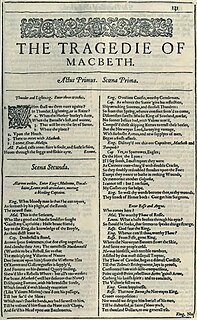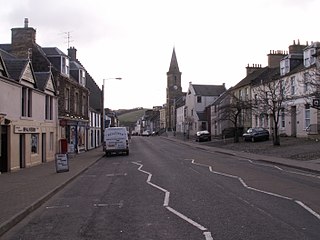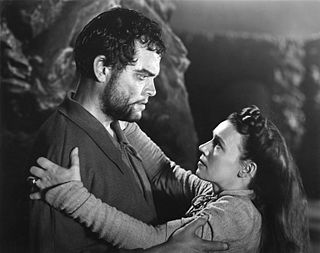
Macbeth is a tragedy by William Shakespeare. It is thought to have been first performed in 1606. It dramatises the damaging physical and psychological effects of political ambition on those who seek power. Of all the plays that Shakespeare wrote during the reign of James I, Macbeth most clearly reflects his relationship with King James, patron of Shakespeare's acting company. It was first published in the Folio of 1623, possibly from a prompt book, and is Shakespeare's shortest tragedy.
Macbeth was King of Scots from 1040 until his death. He ruled over the Kingdom of Alba.
Cináed mac Duib, anglicised as Kenneth III, and nicknamed An Donn, "the Chief" or "the Brown", was King of Scots from 997 to 1005. He was the son of Dub. Many of the Scots sources refer to him as Giric son of Kenneth son of Dub, which is taken to be an error. An alternate explanation is that Kenneth had a son, Giric, who ruled jointly with his father.

Alexander William George Duff, 1st Duke of Fife, styled Viscount Macduff between 1857 and 1879 and known as The Earl Fife between 1879 and 1889, was a British peer who married Princess Louise, the third child and eldest daughter of King Edward VII and Queen Alexandra.

Duke of Fife is a title in the Peerage of the United Kingdom which has been created twice, in both cases for Alexander, 1st Duke of Fife and 6th Earl Fife, who in 1889 married Princess Louise, the eldest daughter of Albert Edward, Prince of Wales, the future King Edward VII.

Lord Macduff, the Thane of Fife, is a character and the main antagonist in William Shakespeare's Macbeth (c.1603–1607) that is loosely based on history. Macduff, a legendary hero, plays a pivotal role in the play: he suspects Macbeth of regicide and eventually kills Macbeth in the final act. He can be seen as the avenging hero who helps save Scotland from Macbeth's tyranny in the play.

Macbeth is a 1971 historical drama film directed by Roman Polanski and co-written by Polanski and Kenneth Tynan. A film adaptation of William Shakespeare's tragedy of the same name, it tells the story of the Highland lord who becomes King of Scotland through treachery and murder. The film stars Jon Finch as the title character and Francesca Annis as Lady Macbeth, noted for their relative youth as actors. Themes of historic recurrence, greater pessimism and internal ugliness in physically beautiful characters are added to Shakespeare's story of moral decline, which is presented in a more realistic style.

The title Earl Fife was a title in the Peerage of Ireland created by letters patent dated 26 April 1759 for William Duff (1696–1763) after asserting his descent from Macduff, the medieval Earl of Fife. Though in the Irish peerage, the title implies a connection with Fife in Scotland.
The Earl of Fife or Mormaer of Fife was the ruler of the province of Fife in medieval Scotland, which encompassed the modern counties of Fife and Kinross. Due to their royal ancestry, the earls of Fife were the highest ranking nobles in the realm, and had the right to crown the king of Scots.

Newburgh is a royal burgh and parish in Fife, Scotland, at the south shore of the Firth of Tay. The town has a population of 2,171, which constitutes a 10% increase since 1901 when the population was counted at 1,904 persons.

Clan MacDuff or Clan Duff is a Lowland Scottish clan. The clan does not currently have a chief and is therefore considered an Armigerous clan, which is registered with the Lyon Court. The early chiefs of Clan MacDuff were the original Earls of Fife, although this title went to the Stewarts of Albany in the late fourteenth century. The title returned to the MacDuff chief when William Duff was made Earl Fife in 1759. His descendant Alexander Duff was made Duke of Fife in 1889.
David Charles Carnegie, 4th Duke of Fife is a British peer. He is the only surviving son of the late James Carnegie, 3rd Duke of Fife, and his former wife Caroline Dewar. He was styled Earl of Macduff until 1992, and then Earl of Southesk until succeeding his father on 22 June 2015 as the fourth Duke of Fife and Chief of the Clan Carnegie.

Clan Brodie is a Scottish clan whose origins are uncertain. The first known Brodie chiefs were the Thanes of Brodie and Dyke in Morayshire. The Brodies were present in several clan conflicts, and during the civil war were ardent covenanters. They resisted involvement in the Jacobite uprisings, and the chief's family later prospered under the British Empire in colonial India.
Causantín or Constantine of Fife is the first man known for certain to have been Mormaer of Fife.

Máel Coluim II, was a 13th-century Mormaer of Fife who ruled the mormaerdom or earldom of Fife between 1228 and 1266. He was the nephew of Máel Coluim I, the previous mormaer, and the son of Máel Coluim I's brother Donnchadh, son of Donnchadh II.

Macduff is a town in the Banff and Buchan area of Aberdeenshire, Scotland. It is situated on Banff Bay and faces the town of Banff across the estuary of the River Deveron. Macduff is a former burgh and was the last place in the United Kingdom where deep-water wooden fishing boats were built.

Lord Macbeth, the Thane of Glamis and quickly the Thane of Cawdor, is the title character and main protagonist in William Shakespeare's Macbeth. The character is loosely based on the historical king Macbeth of Scotland and is derived largely from the account in Holinshed's Chronicles (1577), a compilation of British history.

MacDuff's Castle is a ruined castle near East Wemyss, in Fife, Scotland. The site is associated with the MacDuff Earls of Fife, the most powerful family in Fife in the middle ages, although nothing survives from this period. The present ruins are the remains of the home of the Wemyss family, who lived here from the 14th century, and their successors in the 16th century.

The Feudal Barony of MacDuff is a Scottish Feudal Barony in Macduff, Scotland, contained mostly within the boundaries of the Town of Macduff, in the Banff and Buchan area of Aberdeenshire, Scotland. Clan MacDuff traces origins to the historic, Lowland, Scottish Duff Clan. William Shakespeare's MacBeth has always played a role in the legend of Clan MacDuff, as few can determine the line between The Duff Family history and historical fiction. This ambiguity worked to the benefit of future MacDuff Barons, who were able to prove they were descended from the first Duff to receive a charter in Northeast Scotland. In 1404 David Duff received the charter, in Aberdeenshire, from Robert III of Scotland. In 1759, William Duff was granted the historic Celtic Title of “Fife”, further tying the Duffs of Northeast Scotland, with their ancient Lowland ancestors - the original Earls of Fife from the 11th century. William Duff had five sons - the eldest, James, would become the 2nd Earl Fife and the 1st Baron of MacDuff. James invested heavily in the village of Doune, or “Down”, across the River Deveron from Banff. He built a harbor there in 1760, which quickly became more successful than the harbor at neighboring Banff, which had been established much earlier. In 1783 a charter was granted by King George III, changing the name from Doune to Macduff in his favor and, although a lesser title than Earl, bestowing on him the dignity of the 1st Baron of Macduff.















